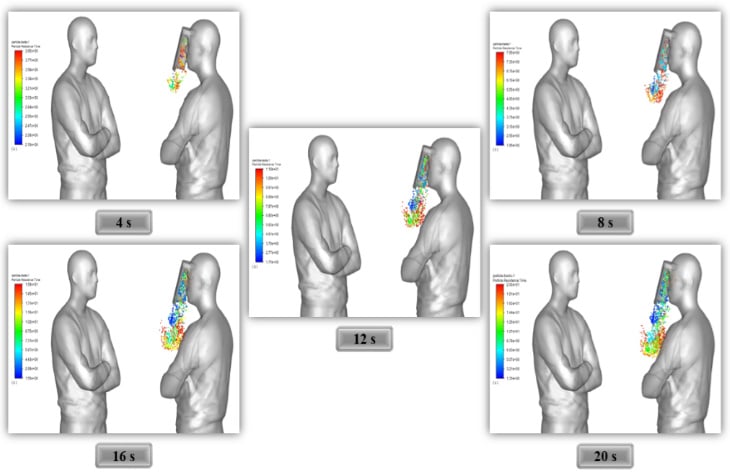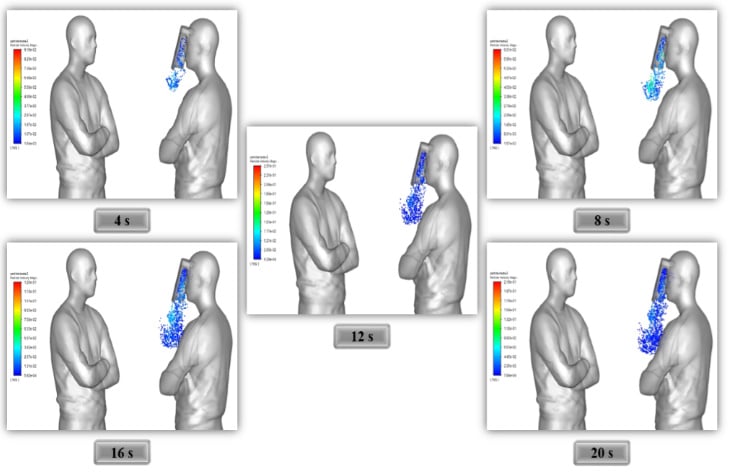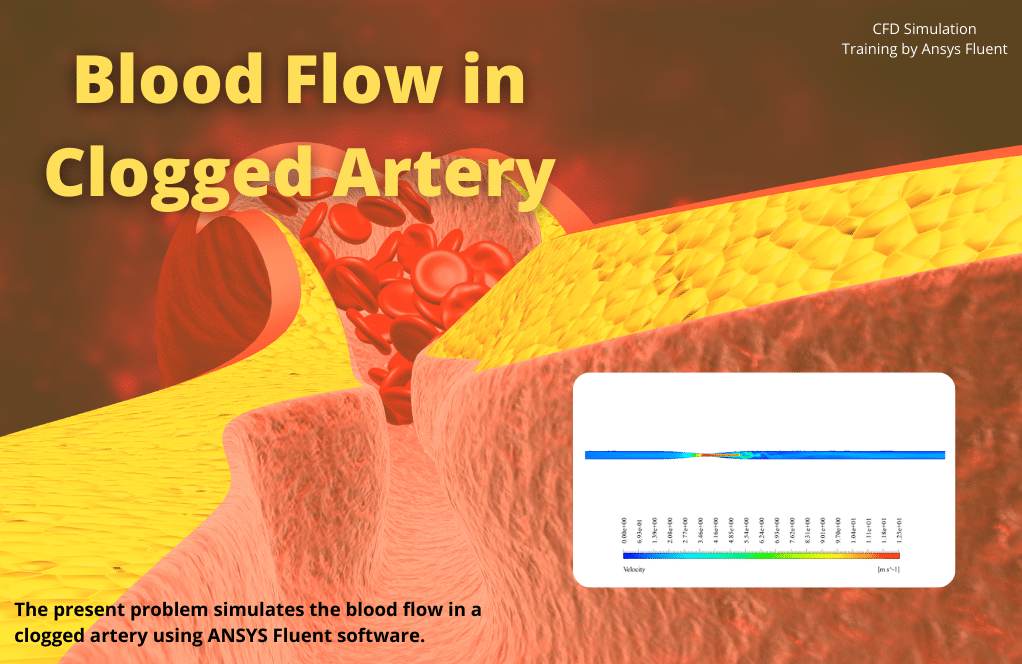Covid-19: Consideration for Wearing Shields, ANSYS Fluent Simulation Training
$100.00 $50.00 Student Discount
- The problem numerically simulates the release of coronavirus particles from a patient’s mouth while talking using ANSYS Fluent software.
- This project investigates the effect of a shield on preventing transmission of the virus particles to another person.
- We design the 3-D model with the Design Modeler software.
- We Mesh the model with ANSYS Meshing software, and the element number equals 724076.
- We perform this simulation as unsteady (Transient).
- We use the DPM to study virus particles Discretely in a continuously fluid space.
- We use a Profile for particle velocity and mass flow rate.
To Order Your Project or benefit from a CFD consultation, contact our experts via email (info@mr-cfd.com), online support tab, or WhatsApp at +44 7443 197273.
There are some Free Products to check our service quality.
If you want the training video in another language instead of English, ask it via info@mr-cfd.com after you buy the product.
Description
Description
This project has tried to simulate the release of coronavirus particles from a patient’s mouth while talking and using wearing shields to prevent transmission to another person using ANSYS Fluent software.
One of the most important recommendations of doctors regarding preventing disease transmission between people is the use of special masks or wearing shields at low social distances. The present model is designed in three dimensions using Design Modeler software.
The model’s geometry includes a computational space measuring 1.6 m * 2 m * 2.6 m in which two people are facing each other at a distance of 80 cm. One of these two people is designed as a patient, so the patient’s mouth is defined as the source of the virus spread caused by talking.
The meshing of the model has been done using ANSYS Meshing software. The element number is 724,076. Also, a transient solver has been used due to the nature of the project (i.e., particle/virus dispersion).
Methodology
This study aims to investigate the ability of virus particles to propagate and transmit at a distance less than a social distance. For the present simulation, the discrete phase model (DPM) is used; Because this model allows us to study a mass of particles discretely or bit by bit in a continuously fluid space.
Due to this model’s choice, the virus particles secreted from the patient’s mouth are considered a discrete phase. The open airflow in the computational area is regarded as a continuous phase.
The type of discrete phase behavior will be time-dependent and with a time step of 0.001 s (by Active surface unsteady particle tracking mode).
After activating the discrete phase model, the Injection process must be defined, determining the type and quality of discrete particles injected into the model.
After activating the discrete phase model, the injection process must be defined, determining the type and quality of discrete particles injected into the model. In this model, the emitted particles are defined as Inert type, and the injection type is surface and is done through the surface of the patient’s mouth.
These virus particles have a constant diameter of 0.000001 m and a temperature of 310 K, which are spread between 0 s and 20 s.
A specific Profile has been used to define the velocity and flow rate of coronavirus particles exiting the mouth. This profile shows the velocity and diffusion of emitted particles when speaking.
This way, these virus particles are removed from the patient’s mouth time-dependent. The particle velocity profile is defined as a sinusoidal function with a maximum velocity of 0.33 m/s, and the particle flow rate is defined by a specific ratio to the particle velocity.
Also, the boundary conditions related to the discrete phase model are defined so that the particles in the boundary related to the patient’s mouth have an Escape state, meaning that the particles pass through this boundary.
Masks or shields mounted on the patient’s face have a Trap mode, meaning particles are trapped and accumulate within these boundaries.
Also the RNG k-epsilon model and energy equation also surfaced to solve the turbulent fluid equations and calculate the temperature distribution inside the domain, respectively.
Conclusion
At the end of the solution process, the particle tracking of the virus particles at different time intervals of the simulation process is obtained. This particle sequence is based on the Residence Time and the velocity of the particles.
As seen from the images and according to the simulation process defined, the virus particles are expelled periodically from the patient’s mouth in 20 s.
According to the pictures, it can be concluded that the presence of a shield causes the virus particles to come out of the patient’s mouth to accumulate on the shield and not be transmitted to a healthy person.







Gwen Wolff –
What kind of insights do the provided results give about the effectiveness of shields in the context of COVID-19 spread prevention?
MR CFD Support –
The simulation results indicate the effectiveness of shields in preventing the direct transmission of virus particles. Using discrete phase modeling, the results show that virus particles expelled from a patient’s mouth collect on the surface of the shield. Hence, it demonstrates that shields can act as a barrier, reducing the possibility of particles reaching another person and helping in preventing the spread of COVID-19.
Darius Kling –
The training looks very impressive! I learned a lot about virus spread simulation. However, I was wondering if temperature variations between the patient and the surrounding environment affect particle flow, and was this considered in the simulation settings?
MR CFD Support –
Yes, temperature variations can impact the behavior of the particles due to density differences that affect buoyancy. In this simulation, the energy equation was solved, which suggests that heat transfer and temperature distributions were considered within the domain. This would allow the simulation to account for changes in particle flow due to temperature variations between the patient and the surrounding environment.
Brycen Klein IV –
I’m very intrigued by the attention to detail in this simulation, especially how the flow rate and diffusion of the virus particles were modeled. Could you elaborate on how accurately this simulation represents real-life virus spread, in comparison to actual case studies or experimental data for COVID-19 transmission?
MR CFD Support –
The simulation intends to closely emulate the real-life spread of virus particles by incorporating fluid dynamics principles and realistic boundary conditions. While it may not fully capture the complexity of real-world interactions and factors influencing the transmission of COVID-19, such detailed CFD analysis can offer beneficial insights. Aligning the model with case studies or experimental data requires careful verification and the application of realistic human respiratory actions and environmental influences.
Helga Greenfelder –
This simulation is impressive! It offers a detailed perspective on how effective shields can be in preventing the spread of virus particles due to verbal interactions.
MR CFD Support –
Thank you for your positive feedback! We’re glad you found the simulation insightful and recognized the importance of safety measures such as shields to combat the spread of viruses. Your insights are valued, and it motivates us to continue delivering high-quality simulations.
Dr. Stephan Dickens DVM –
I found the details in this CFD study fascinating, and the visuals really helped understand it. It’s amazing how technology like ANSYS Fluent can help us investigate such important issues. Keep up the good work, MR CFD!
MR CFD Support –
Thank you for your appreciation. We’re glad that our simulation training could provide valuable insights and understanding. We constantly strive to contribute to important research avenues with our expertise in CFD. Your feedback motivates us to continue delivering high-quality trainings and services!
Miss Emmie Robel –
This CFD training was superb! It really illuminated the effectiveness of wearing shields against the transmission of coronavirus. I appreciated how the particle velocity and flow rate emitted during speech was realistically modeled to offer practical insights into protective measures.
MR CFD Support –
Thank you for your positive review! We’re delighted to hear that you found our COVID-19 tutorial comprehensive and useful in demonstrating the utility of wearing shields. Your appreciation for the detail in modeling particle velocity and flow rates bolsters our commitment to providing realistic simulations. Stay safe!
Eulalia Feest –
What improvements can be made to shield designs based on your study to further prevent the spread of the virus?
MR CFD Support –
We’re really grateful that you found our training on Covid-19 shields through ANSYS Fluent insightful. Our study reveals that while shields can be effective barriers, to enhance their effectiveness, adjustments such as angling the top portion of the shield outwards might reduce upward particle flow, potentially also adjusting the bottom edge to tightly follow the chin’s contour. Nonetheless, it’s essential to balance modifications for practical everyday use and comfort while ensuring continued protection.
Prof. Green Kessler –
The simulation sounds comprehensive! It was particularly insightful to learn how the virus particles behave with the presence of a shield. I feel more knowledgeable about safety precautions now. Great job on this insightful simulation training.
MR CFD Support –
Thank you for the compliment! We’re delighted to know that our simulation provided valuable insights and helped increase your understanding of safety measures during these times. If you have any further questions or need in-depth information, feel free to reach out. Stay safe!
Prof. Alejandra Rowe –
I was impressed with the level of detail in the Covid-19 shield simulation! Did the results include details on efficacy—like what percentage of particles the shield blocked from reaching the other person?
MR CFD Support –
The simulation indeed tracks the particle sequence based on Residence Time and particle velocity, giving us valuable insights into how shields can be effective in blocking the transmission of virus particles. While specific percentages aren’t provided in the overview, such simulations typically offer quantitative results that can inform us on the efficacy of the shields. In general, the results have shown that the presence of a shield causes most of the virus particles to accumulate on its surface rather than being transmitted, which would indicate a significant percentage of blocked particles.
Prof. Ramon Lubowitz Sr. –
The detailed description of your Covid-19 particle simulation is fantastic! It’s impressive how technology can be used to evaluate preventative measures. Great work!
MR CFD Support –
Thank you for your kind words! We’re glad that the simulation has provided valuable insights and that you’re impressed with the use of technology in this important field of study. Your feedback is greatly appreciated!
Prof. Jeramie Sipes –
The tutorial looks comprehensive. Will I also learn how to customize and use my own profiles for particle injection in ANSYS Fluent?
MR CFD Support –
Yes, in this simulation training, you will learn to define custom profiles for particle injection, including setting particle velocity as a function and particle flow rate proportional to velocity. You’ll gain the skills to set up and customize your own particle injections in ANSYS Fluent according to your specific project needs.
Myrna Becker Jr. –
The simulation results provide visuals for the particle tracking and effectiveness of the shields. Did it include analysis showing the accumulation of particles on different parts of the shield or just overall effective blocking?
MR CFD Support –
The simulation specifically tracks the virus particles and visualizes their spread and accumulation on the shields. It shows where the particles accumulate, which indicates the effectiveness of different parts of the shield in blocking the spread of the virus.